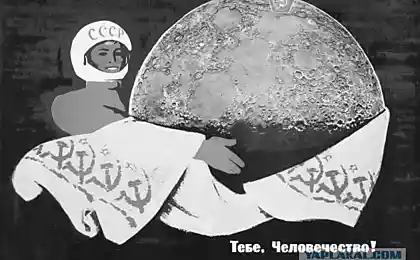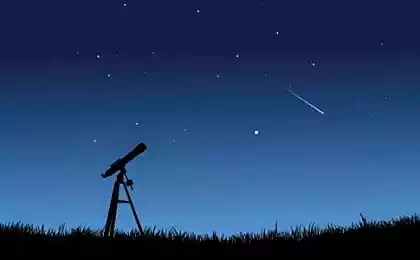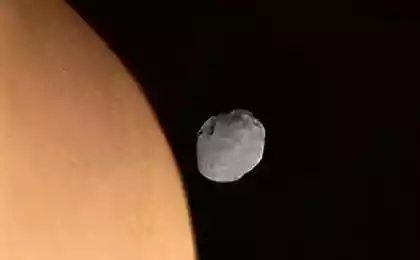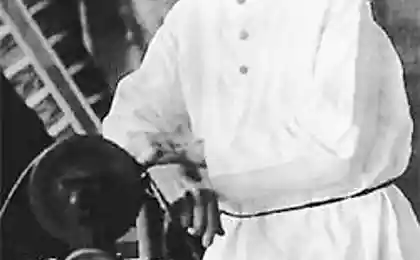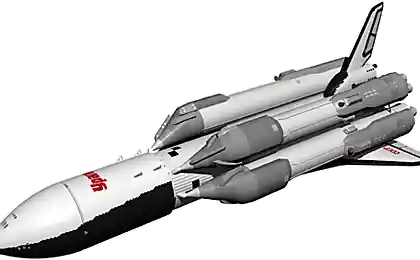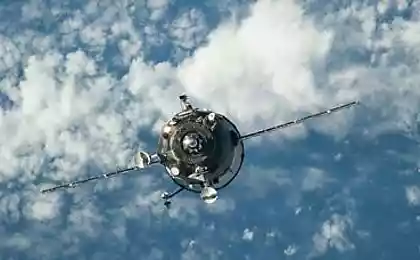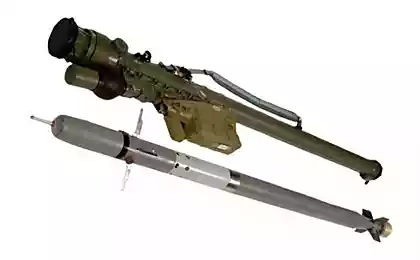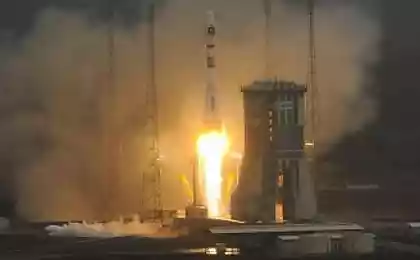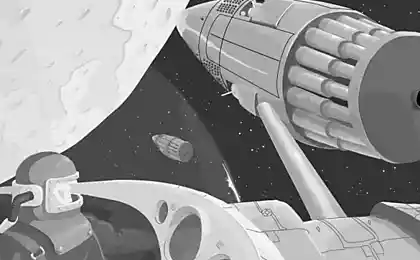2383
As we ran Space Telescope
On Thursday, December 19, 2013 Space Telescope Gaia European Space Agency went into space on a Russian rocket "Soyuz-ST-B" with the upper block "Fregat-MT." Start produced from Kourou in French Guiana.

Launch was a success, and as he passed I was able to watch from the Mission Control Center NPO. SA Lavochkin, where they invited a few bloggers. NPOL is the manufacturer of the upper stage "Fregat", therefore oversees its work during the launch of space. In fact, the team from Moscow MCC on "Frigate" had not been given, but only receives and analyzes information. Therefore, in this mission work function DRM-L - is the provision of information services company Arianspace, which carries the rocket launch. Ie foreign visitors, like any bloggers would not prevent the successful launch of the rocket and the telescope. Unfortunately, these subtleties I did not know, so he left the house a large SLR camera, so as not to distract them employees of the Centre. Tsifromylnitsu took a superzoom that affected the quality of images, for which I apologize to the readers.
Command Start is in French Guiana, and after separation of the device from the upper stage management was transferred to MCC ESA in Darmstadt.
DRM-L is not very similar to the ones of which control or ISS manned launch. It is smaller in size, and there's only one row of desks with computers. But the huge screen in the wall there as it should be.
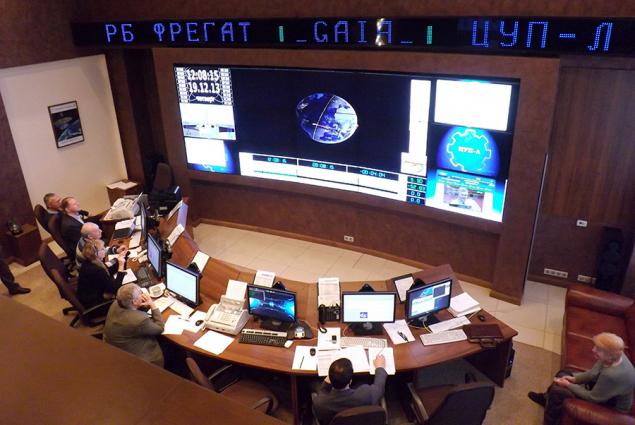
More precisely them here for two. On the second derived information already existing devices NPOL: & quot; Electro-L & quot; and & quot; Spektr-R & quot ;:
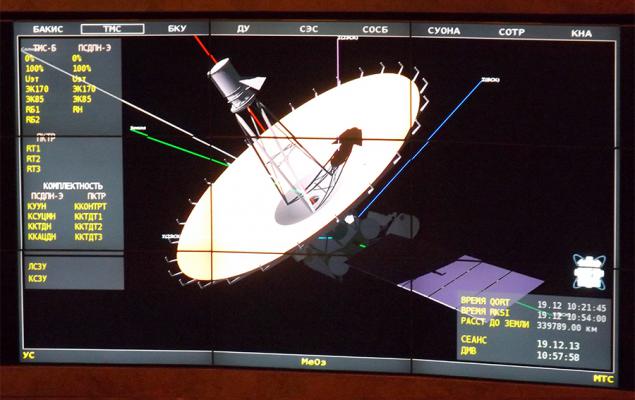
Pay attention to the distance from the Earth, in the lower right corner. Almost flew to the moon. Orientation device on Earth and the Sun in an orbit corresponds to the position in real time, and is determined to transmit telemetry.
In DRM-L we arrived a half hour before the start. We were placed on the balcony, where you can watch the developments and not detract from the work of those who are at the bottom. Loudspeakers broadcast team, who gave at the launch site. Rocket accommodate a few days, so before the start only required to hold the final preparation procedures, and disperse all away from the danger zone.
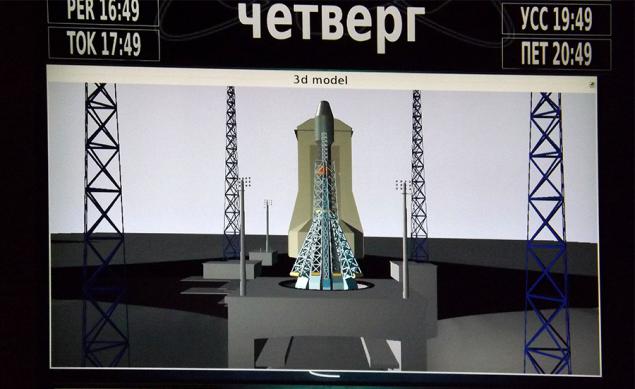
Space on the balcony was filled. Came mainly management representatives, was the chief DRM-L Yuri Kazakevitch, by invitation, we were there; and was the chief designer of "Frigate" Vladimir Asyushkin. General Director Victoria Hart at that time was at the launch site in French Guiana.
To start NPOL this feature - the fortieth "Frigate". Virtually all his missions were successful, except partially successful launch of the satellite "Meridian-2", which brought to an unplanned orbit in 2009, but the fault lies there on the third stage of the rocket, and "Frigate" contrary pulled though the machine somewhere, not letting fall. Failure can only be considered "Phobos-Grunt", it was created on the basis of "Frigate", but there has been completely replaced the control system, and introduced a number of design changes, so technically it was not the "Frigate". In general, today it is one of the most reliable boosters Russia, which explains why they are Europeans.

Meanwhile, on the launch pad commanded "minute alert." I already knew that this does not mean the start of a minute. Prior to the start there were still a few minutes, but the tension grew. Visitors balcony MCC that before talking or reading patterns, and ballistic data, rose and stared at the monitors.

There's art tried to establish a live broadcast from the spaceport. Suitable relay satellite was not, therefore, have given a picture from the site Arianspace . Curiously, it was a 60-second delay, ie, we have received information one minute earlier than the rest of the world.
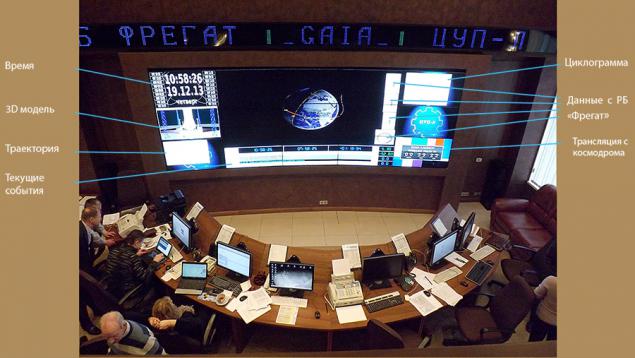
French representatives were located at the bottom left. There you can see the fax. Although this device seems anachronistic today, but it is a method of transmitting information received in Arianspace. However, Roskosmos, fax also works more readily than by e-mail.
On the central monitor was derived model of the Earth, with a distinguished trajectory of a missile and booster. Red color indicates the active sites which employ rocket motors, white color - passive. Yellow ring - a line terminator, ie border day and night. Yellow on the surface of the designated tracking station: Galliot, Natal, Asanson (Ascension Island), Libreville, Mauritius, Perth, which receive information from the spacecraft:
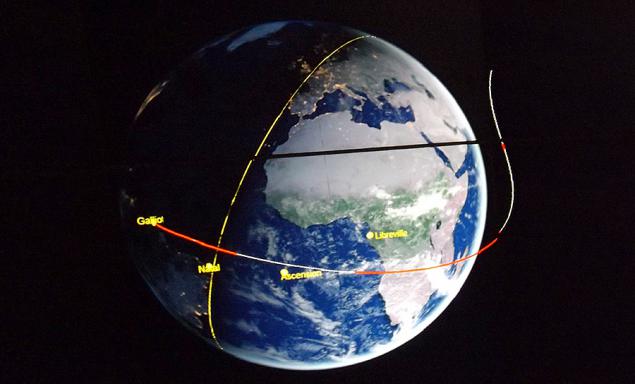
Remember the Soviet scientific ships with giant plates?
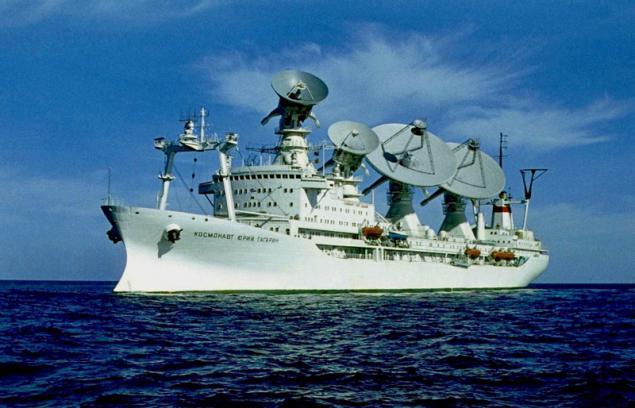
That's what they were needed - to control the flight of our devices where there is no possibility of "lead" them from the earth. Now Russia has no such ships, so a significant part of the way our machines are flying in the blind spot. Only in terms of force majeure, the aliens we can provide assistance to their stations. For example, "Phobos-Grunt" caught the world ...
Sounded cherished team & quot; key to the start i> & quot ;, & quot; Feeding i> & quot ;, & quot; Purge i> & quot; ... «There is a contact lift":
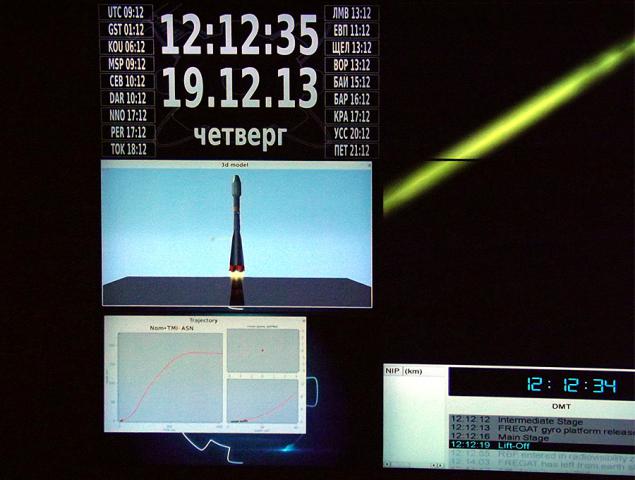
Everyone froze staring at the numbers on the monitors. It was our "nine minutes of terror". "Union" - reliable rocket, but from mistakes no one is immune, so the voltage has reached the limit.
While flying rocket team gave Samarians and dry reports & quot; System Settings control rate i> & quot ;, & quot; design parameters normally i> & quot ;, & quot; The engine of the second stage is working properly i> & quot ;, & quot; The stabilization products stable i> & quot ;, was heard genuine pride and, it seemed to me, even some aggression. As if it was throwing these phrases all the skeptics who took the time to write about the ocean satellite constellation, when they heard that Gaia is derived "Union».

Finally the long awaited sounded to Samara, a report: & quot; There are third-stage engine shutdown. There department head unit. The upper stage "Fregat-MT" with the spacecraft Gaia displayed on a non-closed orbit. Reporting is over i> & quot ;.
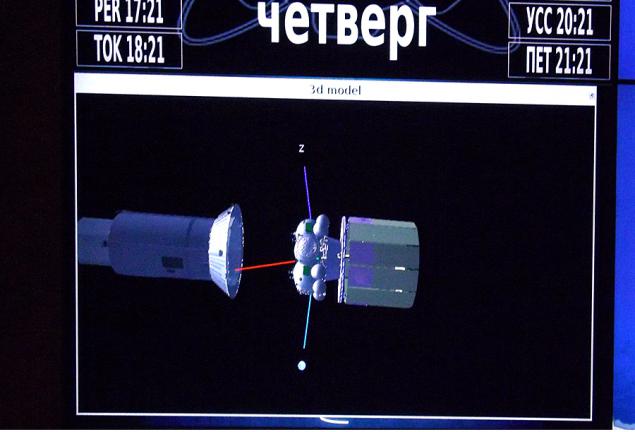
Short life began "Frigate».
Non-closed orbit means that no additional booster pulse spacecraft re-entered to the dense layers of the atmosphere and burned. The upper stage is necessary to bring the speed up to the first space and continue to work, in order to send a telescope escape trajectories. First start marching propulsion need to set the first cosmic velocity, and enter the reference orbit. Then, over the Atlantic, took a passive part of the flight, and then again switched on the engine.
As we were told 15 minute continuous operation of the engine - a record for the "Frigate". He previously treated with shorter pulses. On the engine test showed the possibility of a half-hour of work. Yet it allows for repeated inclusion. Again, tests have proven its ability to carry up to 40 inclusions, although in practice more than six times the engine does not start. Sometimes several satellites in one flight is required to dissolve into different orbits.
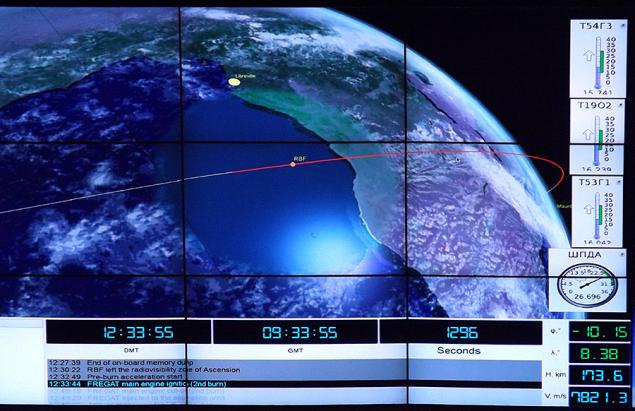
The second engine start at deducing Gaia was necessary to climb and send a telescope into an elliptical orbit. Before lifting the spaceship on the contrary fell slightly, and then later pulled up:
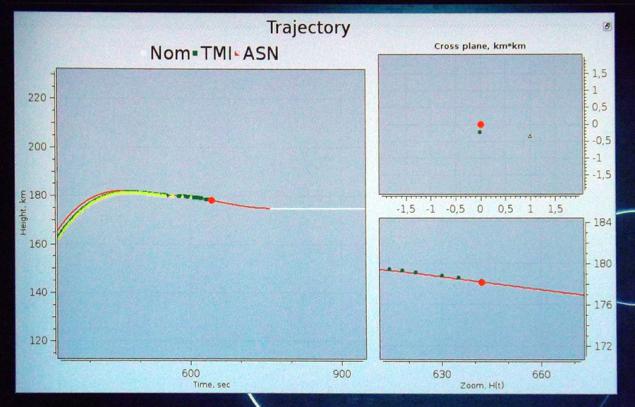
Table shows the trajectories of three values: red-white line - it is the way in which the ship has to fly on the program; green - how it flies according to the on-board device orientation; yellow - according to external surveillance systems.
"Hill" began over Africa. In the diagram, it became apparent as increased limits LOS "Frigate" with increasing altitude. I was hoping that over the Indian Ocean it will rise high enough to be noticeable to the "Electro-L", but it has risen slightly above 1, 5 thousand. Km, which is not enough for the camera meteorological satellite in geostationary orbit.
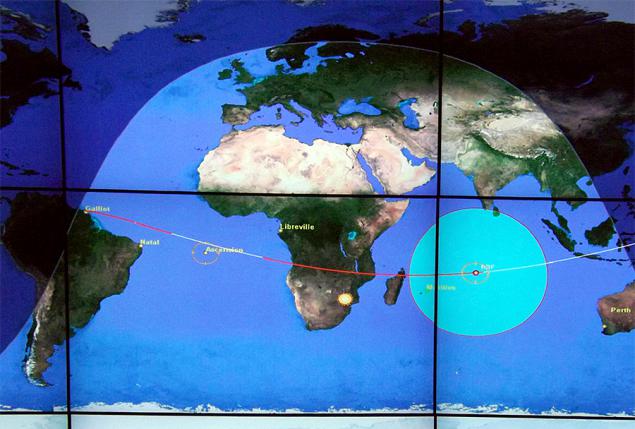
A few minutes after the second engine shutdown "Frigate", held the most important NGO Lavochkin, the day's events. The loudspeaker announced the next message: & quot; commands the Gaia spacecraft separation from the upper stage "Fregat i>», and follow: & quot; Warning. According to telemetry data, there is a separation of the spacecraft i> & quot ;:
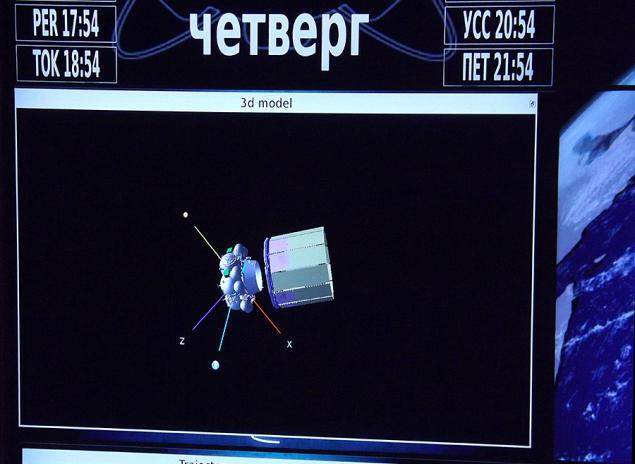
There was applause, the scattered, and everyone rushed to press each other's hands and congratulate. Russia made its contribution to the future success of the Space Telescope and cartographer Galaxy Gaia. It was launched into an elliptical orbit with a maximum height of 952 thousand. Km and a minimum of 350 km. But at least the telescope does not have to come back. He needs to play its own engines to gain escape velocity, and "break" the ellipse to ever leave Earth orbit. The process of acceleration and correction, to enter the escape trajectories should take 96 hours or 4 days, ie, at the moment it is not yet complete. The path to the goal - L2 point of the Earth-Sun, at a distance of 1, 5 million. Km, will take several weeks.
But for "Frigate" work is not yet finished. It had to divert away from the spacecraft to avoid a risk of collision. Normally boosters are trying to drown, not to leave debris in orbit. However, in this case it was not possible due to high speed, high-altitude spacecraft and inadequate supplies of fuel. The only thing that could be done here - to remove the "Frigate" aside.

Third, the inclusion of a short upper stage engine sent into orbit, in fact, eternal storage. Now it will orbit the Earth departure for 2 16 million. Km and returning every 130 days to shoot at us at an altitude of 381 km. The only thing that can be done to prevent excessive space debris - is to spend passivation: fuel tanks open holes through which pitted remains of fuel. Now he, at least, will not explode from heat sunlight. Previously, it has happened with the upper stage and the third stage of the rocket.
After the "Frigate" went to his last journey, we carried upstairs and showed the "brain" DRM-L - analytical department. This is where the main work carried out to provide information to the Mission Control Center - then obtained and analyzed telemetry information. This department struck the difference in age of employees. However, this picture shows the most common state with the staff in the industry. There's managed to make the photo, which I would call the "Russian space today: gray hair and booms»:

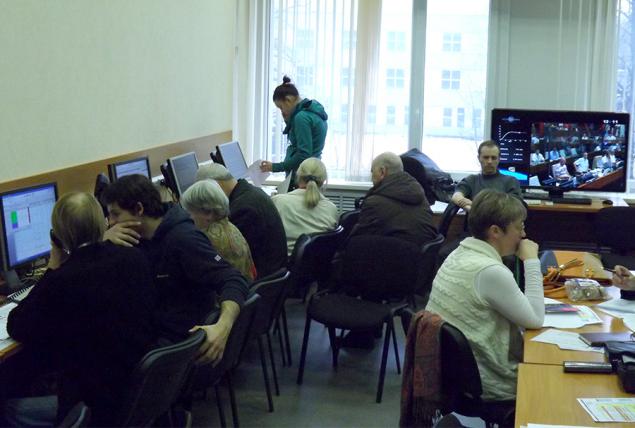
It is hoped that these boys and girls will make another leap forward in your space, like those who now share with them the experience. We can only give moral support to them in this endeavor.
You also need to thank the management of NPO. SA Lavochkin, because they make their first steps in order to make the Russian space more open to the public. I>
Source: habrahabr.ru/post/206936/

Launch was a success, and as he passed I was able to watch from the Mission Control Center NPO. SA Lavochkin, where they invited a few bloggers. NPOL is the manufacturer of the upper stage "Fregat", therefore oversees its work during the launch of space. In fact, the team from Moscow MCC on "Frigate" had not been given, but only receives and analyzes information. Therefore, in this mission work function DRM-L - is the provision of information services company Arianspace, which carries the rocket launch. Ie foreign visitors, like any bloggers would not prevent the successful launch of the rocket and the telescope. Unfortunately, these subtleties I did not know, so he left the house a large SLR camera, so as not to distract them employees of the Centre. Tsifromylnitsu took a superzoom that affected the quality of images, for which I apologize to the readers.
Command Start is in French Guiana, and after separation of the device from the upper stage management was transferred to MCC ESA in Darmstadt.
DRM-L is not very similar to the ones of which control or ISS manned launch. It is smaller in size, and there's only one row of desks with computers. But the huge screen in the wall there as it should be.

More precisely them here for two. On the second derived information already existing devices NPOL: & quot; Electro-L & quot; and & quot; Spektr-R & quot ;:

Pay attention to the distance from the Earth, in the lower right corner. Almost flew to the moon. Orientation device on Earth and the Sun in an orbit corresponds to the position in real time, and is determined to transmit telemetry.
In DRM-L we arrived a half hour before the start. We were placed on the balcony, where you can watch the developments and not detract from the work of those who are at the bottom. Loudspeakers broadcast team, who gave at the launch site. Rocket accommodate a few days, so before the start only required to hold the final preparation procedures, and disperse all away from the danger zone.

Space on the balcony was filled. Came mainly management representatives, was the chief DRM-L Yuri Kazakevitch, by invitation, we were there; and was the chief designer of "Frigate" Vladimir Asyushkin. General Director Victoria Hart at that time was at the launch site in French Guiana.
To start NPOL this feature - the fortieth "Frigate". Virtually all his missions were successful, except partially successful launch of the satellite "Meridian-2", which brought to an unplanned orbit in 2009, but the fault lies there on the third stage of the rocket, and "Frigate" contrary pulled though the machine somewhere, not letting fall. Failure can only be considered "Phobos-Grunt", it was created on the basis of "Frigate", but there has been completely replaced the control system, and introduced a number of design changes, so technically it was not the "Frigate". In general, today it is one of the most reliable boosters Russia, which explains why they are Europeans.

Meanwhile, on the launch pad commanded "minute alert." I already knew that this does not mean the start of a minute. Prior to the start there were still a few minutes, but the tension grew. Visitors balcony MCC that before talking or reading patterns, and ballistic data, rose and stared at the monitors.

There's art tried to establish a live broadcast from the spaceport. Suitable relay satellite was not, therefore, have given a picture from the site Arianspace . Curiously, it was a 60-second delay, ie, we have received information one minute earlier than the rest of the world.

French representatives were located at the bottom left. There you can see the fax. Although this device seems anachronistic today, but it is a method of transmitting information received in Arianspace. However, Roskosmos, fax also works more readily than by e-mail.
On the central monitor was derived model of the Earth, with a distinguished trajectory of a missile and booster. Red color indicates the active sites which employ rocket motors, white color - passive. Yellow ring - a line terminator, ie border day and night. Yellow on the surface of the designated tracking station: Galliot, Natal, Asanson (Ascension Island), Libreville, Mauritius, Perth, which receive information from the spacecraft:

Remember the Soviet scientific ships with giant plates?

That's what they were needed - to control the flight of our devices where there is no possibility of "lead" them from the earth. Now Russia has no such ships, so a significant part of the way our machines are flying in the blind spot. Only in terms of force majeure, the aliens we can provide assistance to their stations. For example, "Phobos-Grunt" caught the world ...
Sounded cherished team & quot; key to the start i> & quot ;, & quot; Feeding i> & quot ;, & quot; Purge i> & quot; ... «There is a contact lift":

Everyone froze staring at the numbers on the monitors. It was our "nine minutes of terror". "Union" - reliable rocket, but from mistakes no one is immune, so the voltage has reached the limit.
While flying rocket team gave Samarians and dry reports & quot; System Settings control rate i> & quot ;, & quot; design parameters normally i> & quot ;, & quot; The engine of the second stage is working properly i> & quot ;, & quot; The stabilization products stable i> & quot ;, was heard genuine pride and, it seemed to me, even some aggression. As if it was throwing these phrases all the skeptics who took the time to write about the ocean satellite constellation, when they heard that Gaia is derived "Union».

Finally the long awaited sounded to Samara, a report: & quot; There are third-stage engine shutdown. There department head unit. The upper stage "Fregat-MT" with the spacecraft Gaia displayed on a non-closed orbit. Reporting is over i> & quot ;.

Short life began "Frigate».
Non-closed orbit means that no additional booster pulse spacecraft re-entered to the dense layers of the atmosphere and burned. The upper stage is necessary to bring the speed up to the first space and continue to work, in order to send a telescope escape trajectories. First start marching propulsion need to set the first cosmic velocity, and enter the reference orbit. Then, over the Atlantic, took a passive part of the flight, and then again switched on the engine.
As we were told 15 minute continuous operation of the engine - a record for the "Frigate". He previously treated with shorter pulses. On the engine test showed the possibility of a half-hour of work. Yet it allows for repeated inclusion. Again, tests have proven its ability to carry up to 40 inclusions, although in practice more than six times the engine does not start. Sometimes several satellites in one flight is required to dissolve into different orbits.

The second engine start at deducing Gaia was necessary to climb and send a telescope into an elliptical orbit. Before lifting the spaceship on the contrary fell slightly, and then later pulled up:

Table shows the trajectories of three values: red-white line - it is the way in which the ship has to fly on the program; green - how it flies according to the on-board device orientation; yellow - according to external surveillance systems.
"Hill" began over Africa. In the diagram, it became apparent as increased limits LOS "Frigate" with increasing altitude. I was hoping that over the Indian Ocean it will rise high enough to be noticeable to the "Electro-L", but it has risen slightly above 1, 5 thousand. Km, which is not enough for the camera meteorological satellite in geostationary orbit.

A few minutes after the second engine shutdown "Frigate", held the most important NGO Lavochkin, the day's events. The loudspeaker announced the next message: & quot; commands the Gaia spacecraft separation from the upper stage "Fregat i>», and follow: & quot; Warning. According to telemetry data, there is a separation of the spacecraft i> & quot ;:

There was applause, the scattered, and everyone rushed to press each other's hands and congratulate. Russia made its contribution to the future success of the Space Telescope and cartographer Galaxy Gaia. It was launched into an elliptical orbit with a maximum height of 952 thousand. Km and a minimum of 350 km. But at least the telescope does not have to come back. He needs to play its own engines to gain escape velocity, and "break" the ellipse to ever leave Earth orbit. The process of acceleration and correction, to enter the escape trajectories should take 96 hours or 4 days, ie, at the moment it is not yet complete. The path to the goal - L2 point of the Earth-Sun, at a distance of 1, 5 million. Km, will take several weeks.
But for "Frigate" work is not yet finished. It had to divert away from the spacecraft to avoid a risk of collision. Normally boosters are trying to drown, not to leave debris in orbit. However, in this case it was not possible due to high speed, high-altitude spacecraft and inadequate supplies of fuel. The only thing that could be done here - to remove the "Frigate" aside.

Third, the inclusion of a short upper stage engine sent into orbit, in fact, eternal storage. Now it will orbit the Earth departure for 2 16 million. Km and returning every 130 days to shoot at us at an altitude of 381 km. The only thing that can be done to prevent excessive space debris - is to spend passivation: fuel tanks open holes through which pitted remains of fuel. Now he, at least, will not explode from heat sunlight. Previously, it has happened with the upper stage and the third stage of the rocket.
After the "Frigate" went to his last journey, we carried upstairs and showed the "brain" DRM-L - analytical department. This is where the main work carried out to provide information to the Mission Control Center - then obtained and analyzed telemetry information. This department struck the difference in age of employees. However, this picture shows the most common state with the staff in the industry. There's managed to make the photo, which I would call the "Russian space today: gray hair and booms»:


It is hoped that these boys and girls will make another leap forward in your space, like those who now share with them the experience. We can only give moral support to them in this endeavor.
You also need to thank the management of NPO. SA Lavochkin, because they make their first steps in order to make the Russian space more open to the public. I>
Source: habrahabr.ru/post/206936/

